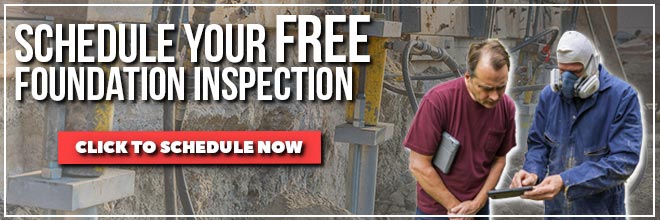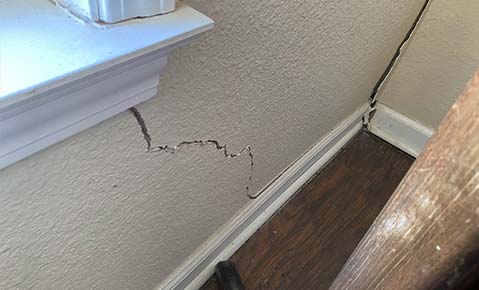Your Arizona home is the largest investment; a refuge for you, your family, and anyone you welcome inside. You want your largest investment to be protected at all costs. You might be a homeowner enduring foundation issues or wanting to get ahead of the game for potential problems in the future.
Either way, you’re educating yourself. And it’s important to Dalinghaus Construction that you’re aware of the top foundation issues in Arizona.
Dalinghaus Construction has been in the foundation repair business since 2015, inspecting over 10,000 homes in Arizona, Nevada, and Southern California. We are licensed and insured in all three states, meaning we have to understand what homeowners endure and the conditions in each state. We know foundation issues in Arizona very well, having done hundreds of foundation repair projects in the state. We want you to know what could be happening with your home.
Why does my AZ home have foundation issues?
You’ll often find issues with foundation settlement and foundation heaving.
Foundation Settlement – Downward movement or sinking of the base of a structure.
Foundation Heaving – The upward movement of a foundation due to an increase in moisture causing soils to expand.
You find foundation settlement to be far more common than heaving. That said, we deal with heaving a little more in Arizona compared to California.
Note – The heaving issues will be due to drainage. There aren’t many gutters on houses in Arizona. It seems not that many people believe in using them since the weather is so hot and you’re basically in the desert.
There is also a grading issue. When a house isn’t graded correctly, the landscape is likely dipping toward the home, making your investment the hip and new hub for moisture. All the clay soils have a party and overindulge themselves in moisture. The soil doesn’t handle its moisture well, being that one person at the party causing damage and ruining everyone’s good time.
Advice from our Arizona Project Design Specialist Bryan Wooldridge – The best thing you can do is water diversion. Anything you can do to divert the water will go a long way, whether it’s landscaping your home so the slope is away from your home or adding gutters.
How common are foundation issues in Arizona?
Foundation issues are as common in Arizona as much as Southern California and Nevada. Where the location geography is different, foundation issues come up the same.
Arizona doesn’t have to deal with earthquakes like California does, though that doesn’t stop the soil from moving. The largest issues you’ll find in Arizona are the soil and the mountains with the slopes.
Common signs and symptoms of foundation settlement/heave
- Drywall cracks
- Stucco cracks
- Concrete slab cracks
- Ceiling cracks
- Tile cracks
- Chimney cracks
- Leaning chimney
- Sloping floors
- Doors and windows are hard to open and close
- Water leaks
When dealing with foundation settlement or heave, you’ll find more than one of these signs. So if you’re seeing only hairline cracks by door frames, that likely means the organic materials in the drywall are naturally expanding and contracting depending on the moisture present.
Soils of Arizona
The soil in Arizona is unique. There’s a whole lot of clay soils that soak up moisture or contract due to drying out. These soils expand and contract all the time.
If there’s one thing Arizona is known for, it’s hot weather to dry out those soils.
(And the Grand Canyon, but that’s beside the point.).
There is a unique soil in Arizona as hard as concrete – caliche – that our production team just loves digging into. Sarcasm.
Getting into the northern areas of Arizona that are more mountainous, you’ll have a whole lot of rock and granite. The areas are more susceptible to foundation settlement and lateral movement. When a rock starts to move, it’s hard to stop moving downhill.
Gravity keeps you grounded. Sometimes a little too grounded. So grounded that gravity wants your home to go below grade.
In California, you’ll have lateral movement when an earthquake hits. In Arizona, it will just happen.
Trees that cause foundation problems
A general rule of (green) thumb: Don’t put plants or trees next to your house. Intricate root systems can cause massive damage to your foundation.
Tree roots are nasty in Arizona. There is a whole lot of heat, forcing the roots to look for moisture at any cost. In the summertime, the soil can be up to 130 degrees Fahrenheit.
It just so happens that the cooler temperatures that hold moisture better will be right under your home. You can bet money the roots will go toward your home.
An invasive tree found in Arizona is called the Sissoo. “Invasive” is almost an understatement; their roots are incredibly powerful to where they will easily move concrete footings. Where your foundation might be like the Incredible Hulk, this tree is like Thanos, able to put a beatdown to your foundation like the fight at the beginning of Avengers: Infinity War.
Another tree referred to as an Asian Elm will also cause some pretty good damage from its roots.
Geological hazards in Arizona
As mentioned earlier, Arizona is generally hot and dry. There isn’t too much rain in the state.
That said, Arizona does have monsoon seasons. When monsoons hit, it rains a lot. And if grading isn’t done properly, the moisture will go right toward your home.
Foundation repair methods in Arizona
There aren’t any unique foundation repair methods in Arizona. A repair method you’ll find in Arizona will be similar to another in New Jersey.
When addressing foundation settlement, Dalinghaus Construction will use a galvanized steel push pier system and a galvanized steel helical pier system.
Push Piers – Push piers use the weight of your home to be hydraulically driven into the ground until hitting bedrock.
Helical Piers – Helical Piers use helices on the lead pier to essentially be hydraulically screwed into the ground – like you would see when putting a screw into a piece of wood – until it reaches competent, load-bearing soil.
The purpose of both methods is to stabilize your home so it will no longer sink. You can also choose to lift your home to get it as close to level as when it was first built.
When we do lift the home, we fill in any voids by doing Deep Injection of Polyurethane. Polyurethane is a foam that gets as hard as concrete used for void fill, structural support, and re-leveling properties. Polyurethane foam is not only safe but also non-polluting.
Here is some rock-solid reading on polyurethane with our article The Cost of Underpinning with Polyurethane Deep Injection.
You now know of the foundation issues in Arizona. The next step is to schedule a free foundation evaluation.
You’ve learned about what causes foundation movement, what is unique to foundation issues in Arizona, and foundation repair methods used in Arizona. The next thing to do is schedule a free evaluation with as many companies as you’re comfortable with. You want opinions from the experts, comparisons in price, and to see if your foundation repair company is the right fit for your needs.
You want to make sure you go with a company that knows what they’re doing. You’ll want to ask about their cost. You want to make sure a company is being honest with you. Most of all, you want to know if a company can do the foundation repair right.
Feel free to start with Dalinghaus Construction for a free 60-90 minute inspection of your foundation. We’ll schedule you with one of our Project Design Specialists to look for any problems. And if you’re home is okay, we will let you know.
Read the article Should You Get Multiple Foundation Repair Bids? (How You Benefit) to see how receiving multiple bids works in your favor.
For any questions, call Dalinghaus Construction at (877)360-9277, or click the button below to schedule your free foundation evaluation today!







